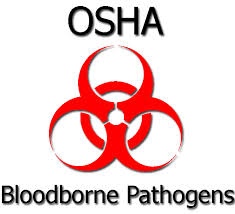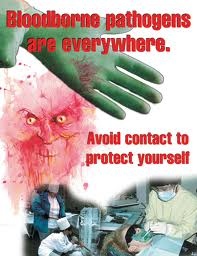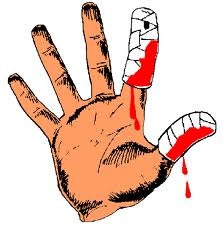Information
-
Conducted on
-
Location
WEEKLY ACCIDENT REVIEW
-
We've had another great week without an injury. Let's make this the safest summer on record!
WEEKLY TOPIC
-
-
What are bloodbourne pathogens?
Bloodbourne pathogens (BBP) are microorganisms that can cause disease when transferred from an infected person to another person through blood or other potentially infected bodily fluids. The microorganisms are capable of causing serious illness and death. The most common diseases spread in this manner are Hepatitis B and Human Immunodeficiency Virus (HIV). Examples of other bloodbourne diseases include malaria, Hepatitis C and syphilis. -
Who is at risk? Workers in health care and public safety jobs could be potentially exposed to these disease pathogens. These workers include, but are not limited to, doctors, dentists, nurses, paramedics, police, laboratory workers and housekeeping workers in the health care industry. Needle stick injuries are the most common method of exposure for health care workers. Non-healthcare workers may become exposed at work while providing help to an injured co-worker and coming in contact with the injured person's blood or body fluids.
-
How do you become exposed? Exposure to bloodbourne pathogens may occur in many ways. Any kind of opening or break in the skin provides a place for infected blood or fluids to enter your body. Scrapes, rashes, cuts, burns, and other minor injuries that create an opening in the skin are entry ways for BBP. Your eyes, nose, and mouth and mucous membranes, and are also openings for diseases to enter.
-
-
Universal precautions. Universal precautions are methods of protecting yourself from BBP. Universal precautions assume all body fluids are infected with BBP. Precautions include:
- Personal Protective Equipment (PPE). To be used at all times to prevent skin or mucous membrane contact with bodily fluids. Always inspect PPE for cracks, holes, or other damage. Never use damaged PPE. PPE includes gloves, eye goggles, face shields, Tyvek suits, etc.
- Wash hands or other skin surfaces thoroughly and immediately if contaminated,
-When using sharp items (scalpels, needles, pipettes, etc.) that may be potentially contaminated, a puncture resistant container must be used for storage and disposal after use. -
If you think you've been exposed or come in contact with blood or other potentially infectious bodily fluids, you've been involved in an exposure incident. Stay calm, wash yourself thoroughly and report to your supervisor right away. Inform your supervisor of how, when, where, and whose blood you came into contact with. If you've been involved in an exposure incident, seek medical attention. A medical professional will provide you with appropriate testing, treatment and education.
-
-
In 1991, the Occupational Safety and Health Administration (OSHA) began requiring employers with workers potentially exposed to blood or other infectious materials to establish a Bloodbourne Pathogen Program. The purpose of a Bloodbourne Pathogen Program is to protect employees from the health hazards associated with bloodbourne pathogens and to provide appropriate treatment and counseling should an employee be exposed to bloodbourne pathogens.
OPPORTUNITY FOR IMPROVEMENT
-
Opportunities for improvement are ALWAYS welcome! Use the Opportunity for Improvement template on iAuditor to submit.
JOBSITE SAFETY CHECKLIST
-
Select date
-
Job Name:
-
Job Number:
-
Checked By:
-
Signature:
1. RECORDKEEPING
-
a. Notices, Posters (5-in1, OSHA Notice, Payroll)
-
b. Emergency Contacts
-
c. OSHA 300 Log
2. PERSONAL PROTECTIVE EQUIPMENT
-
a. In use: Safety glasses, Hard hats, Work boots, Gloves
-
b. Face shields or goggles used for overhead work
-
c. Respirators available
-
d. Welding screens
3. FIRST AID KITS
-
a. Available in gang box and job site trailer
-
b. Stocked adequately with gloves, bandages, and antiseptics
-
c. CPR and First Aid trained personnel
-
d. Medical facility location and contact information communicated
4. SCAFFOLDS
-
a. Competent person certified
-
b. Scaffold grade planking
-
c. Fall protection
-
d. Clear of debris / trash
5. LADDERS
-
a. Free from defects with safety feet, blocked, cleated, or otherwise secured.
-
b. Straight ladders at 1:4 pitch
6. CYLINDERS
-
a. Capped, stored in an upright position
-
b. Oxygen / Acetylene properly separated
-
c. Empty gas cylinders marked
7. TOOLS / EQUIPMENT
-
a. Inspected to ensure safe operating condition
-
b. Hand tools free from defects
-
c. Unsafe / Unusable tools / equipment tagged "Do Not Use"
-
d. Tools / Equipment properly guarded
8. HOUSEKEEPING
-
a. Maintained
-
b. Aisles and exit ways clear with 24" clearance
-
c. Work areas uncluttered and debris removed
9. ELECTRICAL
-
a. Electrical equipment grounded
-
b. Tools double insulated
-
c. Cords in good condition
-
d. Electrical panels covered if energized
10. FALL PROTECTION
-
a. Guard rails, mid rails, toe boards
-
b. Fall restraint systems
-
c. Open sides floors or platforms equipped with standard railing
-
d. Openings (interior / perimeter) properly barricaded or covered
11. FIRE PREVENTION
-
a. Flammable and explosive materials stored safely
-
b. Adequate number of fire extinguishers available with tags and clips
-
c. Vehicles and mobile equipment provided with extinguishers
12. EXCAVATIONS
-
a. Over 4 ft shored, benched, or sloped as required
-
b. Steps or ladders at 25 ft intervals
-
c. Competent person on site
13. HAZARD COMMUNICATION
-
a. MSDS and Labels available
-
b. Employees briefed on HAZCOM
-
c. HAZCOM information poster posted
-
d. Employees familiar with MSDS books and their location
COMMENTS
-
Type comments here or use "Sign" function to write:
-
Write here:
PRE-TASK PLAN
-
Ensure a Pre-Task Plan is completed on paper or via the iAuditor app.
CREW SIGNATURES
-
Add signature
-
Add signature
-
Add signature
-
Add signature
-
Add signature
-
Add signature
-
Add signature
-
Add signature
-
Add signature
-
Add signature
-
Add signature
-
Add signature
-
Add signature
-
Add signature
-
Add signature
















